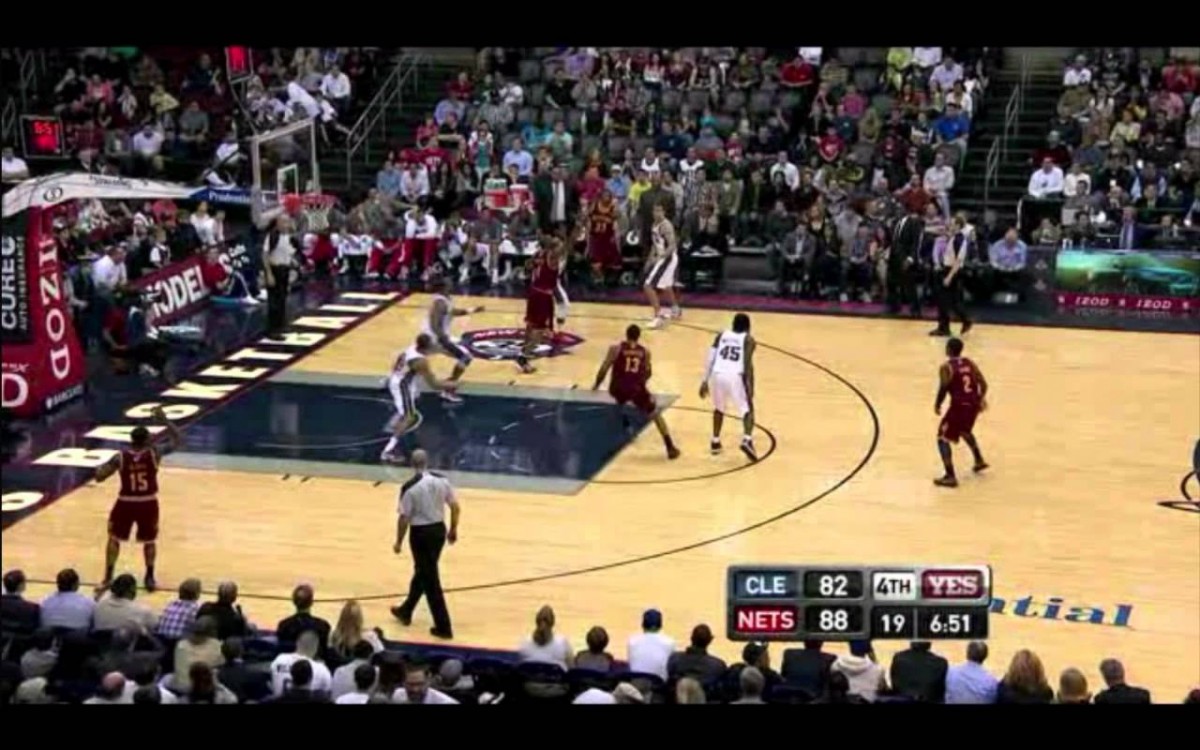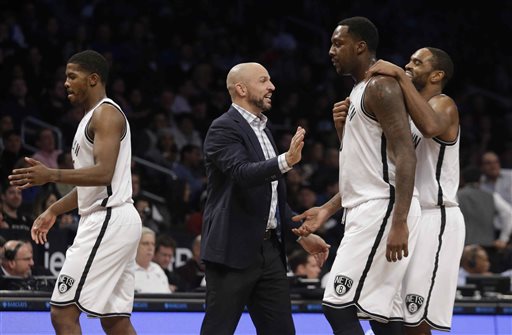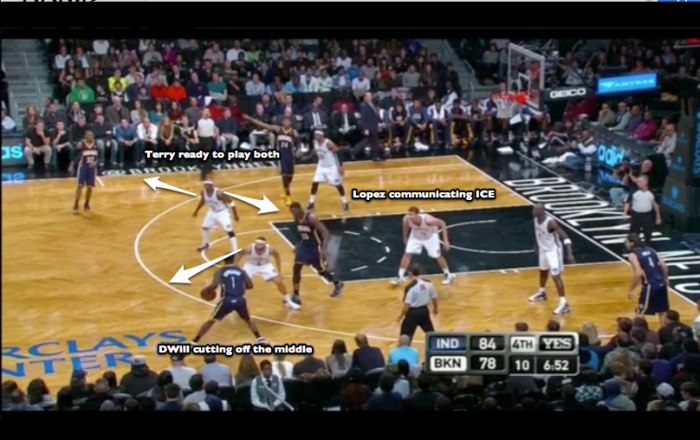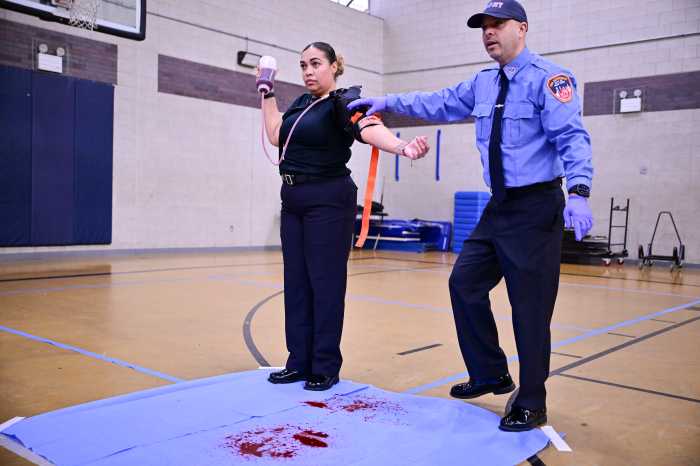With 7 minutes and 11 seconds remaining in the fourth quarter, Shelden Williams grabbed a loose ball, dove towards the basket, and dunked with two hands. The Nets, after trailing by as much as fifteen in the first quarter, had clawed back into the game, sent the crowd into a frenzy, and now held a six-point lead, 88-82.
What happened afterwards: a classic Nets collapse, on both ends of the floor.
Not every play went down the drain — some were glorious, and some key plays kept the Nets within striking distance until only seconds remained on the clock. But in the NBA, execution down the stretch means every single play, and little mistakes during big possessions can cost you victories. What made this one so frustrating is how simple the mistakes were, and how easily this loss could have been avoided.
If you’re unwilling to subject yourself to bad basketball (likely again), I warn you against clicking the jump. What’s detailed below is only the bad. This is the collapse. And remember, every possession listed below occurred in the final 7:11.
The open 3
It’s easy to spot early what the issue is here. Jerry Smith is supposed to guard Donald Sloan in the left corner, but is both a) 15 feet from him, and b) doesn’t have his eyes on him. Shelden Williams, his back-side help in case Sloan cuts, is also looking towards the ball, but he’s also got his man in coverage.
The Cavs run a pick-and-roll in that mid-left corner area. It’s an odd place for a pick-and-roll, but it serves to draw Smith even closer into the play, where he’s now completely abandoned Sloan.
By the time Sloan receives the pass and Smith realizes his mistake, Sloan has far more open space than Smith can make up. Sloan buries the three, as you can see in real time:
The bad jumper
On this play, the Nets start by posting up Anthony Morrow on the left side, but Morrow can’t get decent position. The Nets decide to run Morrow off a Shelden Williams screen across the baseline.
The Cavaliers switch the screen, meaning Shelden Williams has a major mismatch down low. Shelden’s not the most polished post player, but because of the screen all he needs to do is pivot and seal for an easy look at the basket, or a surefire foul if the defense tries to stop him.
Instead of sealing off and looking for the bucket, Shelden floats to the opposite block, leaving Morrow out on an island. Morrow doesn’t need to take this shot, but he does anyway, and as usual with mid-range shots contested closely by the big that switched onto your coverage, it doesn’t end well:
The bad pick-and-roll coverage
On this play, Anthony Parker and Antawn Jamison set up to run a pick-and-roll. Jamison is a stretch four, and Humphries often hedges on pick-and-roll coverages anyway, so Jamison uses that to his advantage; instead of holding the screen and letting Parker run flush into Humphries, he slips towards the basket as soon as Humphries extends his body.
Now, as Humphries is stuck in no man’s land, Shelden Williams has to cover Jamison, who’s now open right near the basket. But since Humphries still needs at least two seconds to recover, that means no one’s behind Shelden to help.
All Jamison needs to do now is dump the ball off to Thompson, who’s got all the space in the world in front of him for an easy, open dunk. Below is the play in real time:
The turned-back defense
With the Nets up 2, the Cavs decide to run a double-screen, with Irving running off Jamison and Thompson across the top left to right. This time, since Humphries can easily switch with Williams and knows Irving’s trying to use both screens, he meets Irving right after the Thompson screen.
Humphries meets Irving up top, cutting off his dribble for a split second while Deron recovers. However, Deron hasn’t hit the second screen yet, and that second screen is what changes this play, along with a particularly poor choice by Humphries.
Humphries turns his back on Irving right as D-Will runs into the second screen, meaning that Irving knows there isn’t any defense if he pulls up for a shot, as Humphries is busy recovering and D-Will is stuck behind Thompson trying to fight through the screen.
Once Humphries realizes his mistake, it’s too late; Irving has already pulled up in rhythm and buries the three. Here is the play in real time:
The poor Iso
Deron Williams isolations are normally a decent play for the Nets, since even his bad shots are higher-percentage shots than some good shots by other Nets players. But in this instance, there were better options. After the Nets isolated Deron right, the Cavs fell back into a zone, playing Thompson over on the ball-side block to cut off D-Will’s penetration. However, in the top right of that square, you’ll see Shelden Williams setting a flare(ish) screen for Gerald Wallace, as Anthony Parker dropped down in the zone. With Shelden’s body on Parker’s weak side, all Deron needed to do was enter the lane and dish out to Wallace for an open corner 3 — the same 3 he hit to end the third quarter Monday night against New Orleans.
Unfortunately, after dribbling around a bit, Deron merely ended up in essentially the same spot as he started in — just a few feet closer, on the elbow. Deron’s turnaround jumper with a hand in his face clanged wide, and until he shot it, Gerald Wallace remained open. You’d expect a player with Deron’s unparalleled court vision to see those types of plays. See for yourself below, in real time:
The breakdown in transition
This play developed out of D-Will’s missed turnaround fadeaway. The rebound bounced out of the paint, got picked up by Anthony Parker, and the Cavs began moving in transition. MarShon Brooks, the first Nets player back, picked up Parker (a career 41% shooter from deep) around the three-point line. The problem here is that the Nets packed around Thompson, who’d killed them all day, and completely forgot about Omri Casspi.
With Shelden and Humphries both picking up Thompson at the foul line and Brooks forced to cut off Parker on the wing, Parker read Brooks’ coverage and immediately passed to Casspi, who knocked down a wide open floater to tie the game at 95. Here is the play in real time:
The darkness in the tunnel
Picking up this play as it develops, Deron Williams elects to call a right-side pick-and-roll play with Kris Humphries, as Gerald Wallace cuts to the left corner.
As the Cavaliers elect to trap with Irving & Thompson, D-Will backs out, bringing the trap far from the basket and creating a classic 4-on-3 situation, with one big in the middle and three shooters surrounding him (two in the corners and one on the opposite wing).
D-Will fires the pass inside to Humphries, and as Humphries turns, the defense begins to collapse. The smartest thing Humphries can do is drive the ball into the lane, drawing the defense even further in, before dishing it out to any one of the shooters around him. Since neither Irving nor Thompson has made an effort to recover defensively, any one of the three options is available.
Humphries proceeds to stare down the basket with the force of an angry boxer. His teammates watch helplessly as he gets his triple-teamed shot rejected and turns the ball over, as you’ll see here in real time:
Jamison in transition
The previous play leads into this one; with the Nets scrambling to react back on defense and Humphries trailing the play, Jamison darts under the basket.
Once he’s established position, Jamison has all the open space in the square to operate. That space shrinks once Irving drives and the defense collapses, but they’re not focused on Jamison, and he’s got the most important space covered: the spot right around the basket.
As two Nets meet Irving in midair and three trail the play, Irving dishes to Jamison under the basket for the easy layup and the 97-95 lead. Here is the play in real time:
The powerless dribble
This is the same play as the pick-and-roll from earlier, just with Gerald Wallace (now playing the 4 instead of Kris Humphries) as the roll man instead of Humphries (now playing the 5 instead of Shelden Williams). Wallace barely sets a screen and D-Will barely uses it, since both of them know what’s happening anyway.
As the trap comes, Deron immediately passes to Wallace, who now has a ton of space to operate in on the right side, space that’ll quickly get filled up by defenders who give him more passing options.
The defense rotates (a novel idea), leaving Wallace with three main options: 1) Dump the ball inside to Humphries, who has an inside track on a dunk, or 2/3) dish out to Brooks or Morrow for the 3. A pass to Brooks is on a tough angle and Morrow appears to be somewhat covered, so Wallace makes what I’d say is the right decision here and passes to Humphries, who can take one step and elevate for the finish.
Unfortunately, Humphries decides to take a power-dribble, bringing the ball down to the floor with three defenders surrounding him inside. This leads to Humphries losing the ball into Omri Casspi’s hands, who he immediately fouls trying to recover. Here is the play in real time:
The game-ender
The video on YES cut off a little late for this one, so I’ll just have to re-enact it for you syntactically. With 19.5 seconds left, the Nets inbounded the ball to Deron Williams. Williams dribbled to the right side and started yet another right-side pick-and-roll with Kris Humphries. Only this time, since the Nets were down three and had no time-outs, Kris Humphries assumed that Deron would pull up for the 3 and he’d crash for the rebound. Only this time, since Kris Humphries had a wide-open lane to the basket after the inevitable trap came, D-Will threw a bounce pass to the wide open Humphries for an easy dunk. Only since Humphries never rolled, he had to lunge for the pass once it was too late, and the ball bounced carelessly out of bounds. Game over.
As mentioned earlier, these are only the bad plays. The Nets got some good looks last night late in the fourth that helped keep them in the game, and some great hustle plays — most notably Wallace drawing a charge on Kyrie Irving with 19.5 seconds left — that gave them a chance. But these are nine plays that drastically altered a close game heavily in one direction. Had the correct read been made, had communication not been severed somewhere, had a poor offensive play not led into a poor defensive play, the Nets might’ve pulled out a victory instead of lamented a loss in the locker room.
I’d avoid using a pinpoint to declare blame when such a collapse required a full-scale decay. The Nets allowed a constant barrage of points in the paint, both by guards and forwards that couldn’t check other guards and forwards on the wings, and by bigs who couldn’t jump with their counterparts. Players didn’t communicate their assignments, particularly late, and it cost them. Coach Avery Johnson, who said before the game he wanted to take the last 20 games to establish a new identity, merely reinforced the old one: no defense at the rim, no stopping a star point guard, no consistent ball movement, and no church in the wild. (Wait, that last one may be Jay-Z.)
But if the Nets continue to spend the last six minutes of games doing whatever you’d call this, they needn’t worry about that top-3 pick. They’ll get it. Goodness knows they’ll need it once everyone leaves for greener pastures.















































